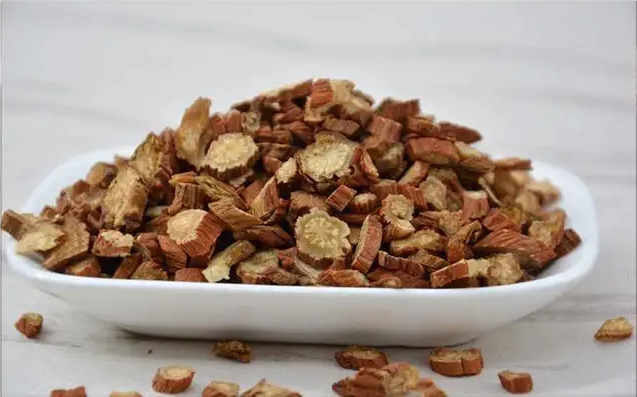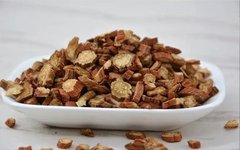Medicinal substances that primarily function to invigorate blood circulation, regulate menstruation, and alleviate pain are referred to as huoxue tiaojing yao (blood-invigorating and menstrual-regulating herbs). Most of these herbs possess properties that are pungent, dispersing, bitter, and draining, primarily entering the gan jing (liver meridian) and blood aspect, with the ability to invigorate blood and dispel stasis, particularly effective in unblocking blood vessels and regulating menstrual flow. They are indicated for menstrual irregularities, dysmenorrhea, amenorrhea, and postpartum abdominal pain due to blood stasis; they are also commonly used for blood stasis pain syndromes, masses, traumatic injuries, and abscesses.
In women, conditions of blood stasis related to menstruation are often associated with dysfunction in the liver’s ability to disperse. Therefore, when using blood-invigorating and menstrual-regulating herbs, they are often combined with substances that soothe the liver and regulate qi. Additionally, different blood-invigorating and menstrual-regulating herbs should be selected based on the underlying causes of the stasis, along with appropriate combinations.

Dan Shen
Shen Nong’s Materia Medica
Refers to the root of the plant Dan Shen (Salvia miltiorrhiza Bge.), which is primarily cultivated and found in most regions of China, especially in Sichuan, Anhui, Jiangsu, Henan, and Shanxi. It is harvested in spring and autumn, with stems and leaves removed, cleaned, soaked, sliced thickly, and dried. It can be used raw or wine-fried.
Properties: Bitter, slightly cold. Enters the heart, pericardium, and liver meridians.
Functions: Invigorates blood, regulates menstruation, dispels stasis and alleviates pain, cools blood and resolves abscesses, calms the mind.
Applications:
1. Menstrual irregularities, amenorrhea, dysmenorrhea, and postpartum abdominal pain due to blood stasis.
Dan Shen is particularly effective in invigorating blood and dispelling stasis, with a slightly cold nature that promotes new blood generation without harming the righteous qi, making it a common herb for gynecological menstrual regulation. The Ben Cao Gang Mu states it “can break up stagnant blood and replenish new blood.” The Gynecology Theory mentions, “A formula of Dan Shen has effects similar to that of the Si Wu Tang.” Clinically, it is often used for menstrual irregularities, amenorrhea, dysmenorrhea, and postpartum abdominal pain due to stasis. Due to its cold nature, it is particularly suitable for conditions of blood heat and stasis. It can be used alone in powdered form mixed with wine, as in the Dan Shen San from the Women’s Complete Good Prescriptions; it is also commonly combined with Chuan Xiong (Ligusticum chuanxiong), Dang Gui (Angelica sinensis), and Yi Mu Cao (Leonurus japonicus), as in the Ning Kun Zhi Bao Dan from the Hygiene Hong Bao. When combined with Wu Zhu Yu (Evodia rutaecarpa) and Rou Gui (Cinnamon), it can treat cold-induced blood stasis.
2. Blood stasis causing heart pain, abdominal pain, masses, traumatic injuries, and rheumatic pain.
This herb is effective in promoting blood circulation, dispelling stasis, and is widely used for various blood stasis conditions. For treating blood stasis obstructing the vessels causing chest pain, abdominal pain, it can be combined with Sha Ren (Amomum villosum) and Tan Xiang (Santalum album), as in the Dan Shen Yin from the Medical Golden Needle; for treating masses, it can be combined with San Leng (Sparganium stoloniferum) and E Zhu (Curcuma zedoaria); for traumatic injuries with blood stasis pain, it is often used with Dang Gui, Ru Xiang (Boswellia), and Mo Yao (Myrrh), as in the Huo Luo Xiao Ling Dan from the Medical Zhong Zhong Can Xi Lu; for rheumatic pain, it can be combined with Fang Feng (Saposhnikovia divaricata) and Qin Jiao (Gentiana macrophylla) to dispel wind and eliminate dampness.
3. Abscesses and swellings due to heat and toxicity.
This herb is cold in nature, capable of cooling blood and invigorating blood, as well as clearing heat and resolving abscesses, making it suitable for abscesses and swellings caused by heat toxicity and blood stasis. It is often combined with herbs that clear heat and detoxify. For treating early-stage breast abscesses, it can be used with Jin Yin Hua (Lonicera japonica) and Lian Qiao (Forsythia suspensa), as in the Xiao Ru Tang from the Medical Zhong Zhong Can Xi Lu.
4. Irritability and insomnia due to heat disease, as well as palpitations and insomnia.
This herb enters the heart channel, capable of clearing heat and cooling blood, calming the mind, invigorating blood, and nourishing blood to calm the spirit. It is used for irritability and insomnia due to heat pathogens entering the heart and nourishing aspect, and can be combined with Sheng Di (Rehmannia glutinosa), Xuan Shen (Scrophularia ningpoensis), Huang Lian (Coptis chinensis), and Zhu Ye (Lophatherum gracile); for insomnia and palpitations due to blood deficiency, it is often used with Sheng Di, Suan Zao Ren (Ziziphus jujuba), and Bai Zi Ren (Platycladus orientalis), as in the Tian Wang Bu Xin Dan from the Secret Dissection of Life.
Dosage: Decoction, 5-15g. For invigorating blood and dispelling stasis, it is best used wine-fried.
Precautions: Avoid with Li Lu (Veratrum). Use cautiously in pregnant women.
Ancient Text Excerpts:
1. Ri Hua Zi Ben Cao: “Nourishes blood and calms the spirit, regulates joints, treats cold and heat fatigue, joint pain, and limb paralysis; relieves distension and pain, promotes muscle growth; breaks up stagnant blood and replenishes new blood; calms pregnancy and expels dead fetus; stops bleeding, regulates women’s menstrual irregularities, and alleviates heart vexation due to blood evil; treats sores, scabies, goiter, swellings, and toxins; headaches, red eyes; heat disease causing oppression.”
2. Dian Nan Ben Cao: “Nourishes the heart and calms the spirit. Treats forgetfulness, anxiety, and insomnia.”
3. Ben Cao Bian Du: “Dan Shen, functions similarly to Si Wu, can dispel stasis to generate new blood, effectively treats wind and disperses masses, with a balanced nature that promotes blood flow… Its sweet and bitter taste regulates menstruation, but primarily opens the nourishing aspect. Although Dan Shen has ‘shen’ in its name, its blood-replenishing power is insufficient, while its blood-invigorating power is abundant, making it the primary herb for regulating the blood aspect. Its efficacy in treating wind and dissipating masses is also due to blood circulation eliminating wind; when blood flows, masses resolve naturally.”
Modern Research:
1. Chemical Composition: Primarily contains lipid-soluble and water-soluble components. Lipid-soluble components include Dan Shen Keton I, Dan Shen Keton II A, Dan Shen Keton II B, Dan Shen Keton III, Hidden Dan Shen Keton, Hydroxy Dan Shen Keton, Dan Shen Acid Methyl Ester, Purple Dan Shen Methyl Ester, Purple Dan Shen Ethyl Ester, Dan Shen New Keton, Dan Shen Alcohol I, Dan Shen Alcohol II, Dan Shen Alcohol III, Dan Shen Phenol, Dan Shen Aldehyde, etc. Water-soluble components mainly include Dan Shen Su, Dan Shen Acid Methyl, Ethyl, Propyl, Gallic Acid, Gallic Aldehyde, etc.
2. Pharmacological Effects: Can dilate coronary arteries, increase coronary blood flow, improve myocardial ischemia, promote recovery from myocardial ischemia or injury, and reduce the area of myocardial infarction; can enhance tolerance to hypoxia, providing protective effects on hypoxic myocardium; can improve microcirculation and promote blood flow velocity; can dilate blood vessels and lower blood pressure. It can improve blood rheology, reduce blood viscosity, inhibit platelet aggregation and coagulation function, activate fibrinolysis, and counteract thrombosis; it can protect red blood cell membranes. It can regulate blood lipids and inhibit the formation of atherosclerotic plaques. It can protect liver cells from damage and promote liver cell regeneration, with anti-fibrotic effects. It can promote the healing of fractures and skin incisions. It can protect gastric mucosa and prevent gastric ulcers. It has sedative and analgesic effects on the central nervous system. It has effects on improving kidney function and protecting against ischemic kidney injury. It has anti-inflammatory and anti-allergic effects. It has varying degrees of inhibitory effects on Staphylococcus aureus, various bacilli, certain fungi, and Leptospira.
3. Clinical Research: Dan Shen Shu Xin Pian (each tablet contains 0.2g of Dan Shen extract) was used to treat 323 cases of coronary heart disease, with a total effective rate of symptom improvement of 80.9% and an effective rate of 57.3% for ECG improvement (Journal of Cardiovascular Diseases, 1974, 2(1):5). Compound Dan Shen Injection (4ml, containing 4g of Dan Shen and 4g of Sandalwood) was slowly injected into the contralateral carotid artery of paralyzed limbs mixed with 2.5% glucose or normal saline (40ml), once every other day for a total of 5 treatments. It was used to treat 10 cases of cerebral hemorrhage, 19 cases of cerebral thrombosis, and 1 case of cerebral embolism, with a total effective rate of 96.7% (Shanghai Journal of Traditional Chinese Medicine, 1987, (1):26). Dan Shen Injection (each ml contains 1.5g of raw herb) was administered via intravenous drip once daily, 15-20ml, to treat 104 cases of acute viral hepatitis, with 85 cases cured and a total effective rate of 97% (Shaanxi Journal of Traditional Chinese Medicine, 1980, (6):15). Compound Dan Shen Injection (12ml mixed with 500ml of 0.9% normal saline) was administered via intravenous drip for 20 days to treat 325 cases of diabetes with peripheral neuropathy, resulting in significant symptom improvement with an efficacy of 81.8% (Journal of Integrated Traditional and Western Medicine, 1988, (2):504). Additionally, Dan Shen is widely used clinically for treating chronic liver disease, chronic renal insufficiency, viral myocarditis in children, vasculitis, scleroderma, epidemic hemorrhagic fever, allergic purpura, schizophrenia, pneumonia, vascular headaches, and rhinitis.
4. Adverse Reactions: Some patients may experience stomach pain, reduced appetite, dry mouth and throat, nausea, and vomiting during Dan Shen use, which is related to its ability to inhibit digestive fluid secretion; it is advisable to discontinue use and may take medications such as Wei Shu Ping or Probenecid, and in severe cases, subcutaneous injection of atropine may be required. Some patients with late-stage schistosomiasis and splenomegaly may experience upper gastrointestinal bleeding after taking large doses of Dan Shen; it is advisable to discontinue use and administer hemostatic agents and vitamins. Dan Shen can cause allergic reactions, manifested as generalized skin itching, rashes, urticaria, and in some cases, accompanied by chest tightness, difficulty breathing, chills, dizziness, nausea, vomiting, agitation, followed by pale complexion, cold limbs, sweating, decreased blood pressure, and even fainting or shock. Immediate intramuscular injection of epinephrine or dexamethasone and antihistamines such as Fenofenadine should be administered, along with adjustments using traditional Chinese medicine Sheng Mai San.
Warm Reminder
The prescriptions and Chinese herbs mentioned above should be used under the guidance of a qualified physician; do not use them indiscriminately!
This article and images are sourced from the internet, and copyright belongs to the original author. Please delete if infringed.

